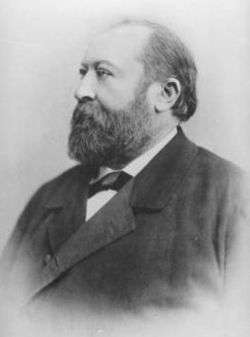Carl Braun (obstetrician)
| Carl Braun (obstetrician) | |
|---|---|
|
Carl Ritter von Fernwald Braun, approx 1880 | |
| Born |
22 March 1822 Zistersdorf, Niederösterreich, Austria |
| Died |
28 March 1891 (aged 69) Wien, Austria |
| Nationality | Austrian, Austro-Hungarian |
| Fields | Obstetrics |
| Institutions | Vienna General Hospital |
Carl Braun (22 March 1822 – 28 March 1891), sometimes Carl Rudolf Braun[1] alternative spelling: Karl Braun,[2] or Karl von Braun-Fernwald, name after knighthood Carl Ritter von Fernwald Braun[3] was an Austrian obstetrician. He was born 22 March 1822 in Zistersdorf, Austria, son of the medical doctor Carl August Braun.
Career
Carl Braun studied in Vienna from 1841 and, in 1847, took the position of Sekundararzt (assistant doctor) in the Vienna General Hospital. In 1849 he succeeded Ignaz Semmelweis as assistant to professor Johann Klein at the hospital's first maternity clinic, a position he held until 1853.
In 1853, after Braun became a Privatdozent, he was appointed ordinary professor of obstetrics in Trient and vice-director of the Tiroler Landes-Gebär- und Findelanstalt. In November 1856 he was called to Vienna to succeed Johann Klein as professor of obstetrics. On Braun's recommendation, the hospital's first gynaecology clinic was created in 1858, under his direction.[4] He is credited for establishing gynaecology as an independent field of study[5]
In 1867-1871 he was appointed dean of the medical faculty, and in the academic year 1868/69 was made rector of the University of Vienna. He was knighted in 1872 (cf. the title Ritter) and in 1877 became a Hofrat, a title reserved for very eminent professors.[4]
His name is associated with a disorder of pregnancy called the "Braun-Fernwald sign".[6] This sign is described as an asymmetrical enlargement and softening of the uterine fundus at the site of implantation at 4–5 weeks.
Views on puerperal fever
Braun was convinced that puerperal fever was caused by miasms and "unfavourable atmospheric-cosmic-terrestrial influences". Braun was consistently hostile to Ignaz Semmelweis; he was not conscientious in using the prophylactic measures necessary to prevent childbed fever, and he did not accept Semmelweis's etiological characterization of the disease.[7]
In a textbook, Braun identified 30 causes of childbed fever; only the 28th of these was cadaverous infection. Other postulated causes included conception and pregnancy, uremia, pressure exerted on adjacent organs by the shrinking uterus, emotional traumas, mistakes in diet, chilling, and atmospheric epidemic influences. Carl Braun's thirty causes appear in his Lehrbuch der Geburtshülfe (Vienna: Braumüller, 1857), p. 914. In the first of these, published in 1855, he mentions Semmelweis in connection with his discussion of cause number 28, cadaverous poisoning. In the later version, however, although he discusses the same cause in the same terms, all references to Semmelweis have been dropped.[8] The impact of Braun's views are clearly visible in the rising mortality rates in the 1850s.
One of Braun's students, August Theodor Stamm, presented papers arguing that improved ventilation, rather than the use of chlorine washings, was responsible for the reduced incidence of puerperal fever at the maternity clinic.[9] Braun himself published papers showing that proper ventilation was the most efficient preventive measure against puerperal fever, e.g.[10] and [11] Braun successfully persuaded the authorities in Vienna to install an expensive new ventilation system in the maternity clinic.[12]
Works
_obstetrician.jpg)
- Klinik der Geburtshilfe und Gynäkologie (im Verein mit Chiari und Spaeth, Erlangen 1855) ([The] Maternity and Gynaecology Clinik, together with Chiari and Spaeth, Erlangen 1855)
- Lehrbuch der Geburtshilfe mit Berücksichtigung der Puerperalprocesse und der Operationstechnik (Wien 1857) (Textbook of obstetrics [also] concerning the puerperal process and surgical technique). Google book search https://books.google.com/books?id=3OOCGAAACAAJ.
- Lehrbuch der gesammten Gynäkologie (2. Aufl., Ib. 1881) (Textbook of Gynaecology, 2nd ed. 1881).[13] WorldCat entry: http://www.worldcat.org/oclc/8179918
- Über 12 Fälle von Kaiserschnitt und Hysterectomie bei engem Becken (mit achtmaligem günstigem Ausgang) (On 12 cases of caesarean section and hysterectomy with narrow pelvis (with eight successful outcomes))
References
- ↑ http://www.worldcat.org/oclc/8179918
- ↑ for example in Bedenek 1983:107, in Swedish bibl. reference and Karl (with K and not C) also in Austrian bibl ref
- ↑ or Carl Rudolf Braun, Ritter von Fernwald
- 1 2 This section almost entirely from Biographisches Lexikon ...
- ↑ Encyclopedia of Austria. http://aeiou.iicm.tugraz.at/aeiou.encyclop.b/b717161.htm;internal&action=_setlanguage.action?LANGUAGE=en, retrieved 28 August 2008
- ↑
- ↑ Carter 1983
- ↑ (Note by translator Carter in footnote 105 p34 in Semmelweis (1861)
- ↑ Stamm, August Theodor (1864). "Ueber die Vernichtungsmöglichkeit des epidemischen Puerperalfiebers". Wiener medizinische-Halle. 5. The essay appears in short segments between pages 157 and 477. Quoted in Carter 2005:86,94
- ↑ Braun, Carl. "Über Luftwechsel und Puerperalkrankheiten". Wiener medizinische Wochenschaft. 14: cols. 257–259. Quoted in Carter 2005:86,94
- ↑ Braun, Carl (1864). "Über Luftwechsel, den neuen Ventilations-Bau mit Benützung der natürlichen Temperaturdifferenzen und Luftströmung". Medizinische Jahrbücher. 20: 165–208. Quoted in Carter 2005:86,94
- ↑ Carter 2005:86
- ↑ ref Biographisches Lexikon ...
- Semmelweis, Ignaz (1861). Etiology, Concept and Prophylaxis of Childbed Fever. K. Codell Carter (translator and extensive foreword). University of Wisconsin Press, September 15, 1983. ISBN 0-299-09364-6. p92 footnote 15
- Carter, K. Codell; Barbara R. Carter (February 1, 2005). Childbed fever. A scientific biography of Ignaz Semmelweis. Transaction Publishers. ISBN 978-1-4128-0467-7.
- Braun, Carl Ritter von Fernwald. Pagel: Biographisches Lexikon hervorragender Ärzte des neunzehnten Jahrhunderts. Berlin, Wien 1901, Sp. 229-231. (in German)
- Corroborated by source provided in Swedish wiki Nordisk familjebok, 1904–1926 http://runeberg.org/nfbd/0035.html (in Swedish)
- Benedek, István (1983). Semmelweis Krankheit. Budapest, Hungary: Akadémiai Kiadó (Translated from Hungarian to German by Alfred Falway). ISBN 963-05-3428-2.
- Österreich-Lexikon http://aeiou.iicm.tugraz.at/aeiou.encyclop.b/b717161.htm, retrieved 28 Aug 2008,
